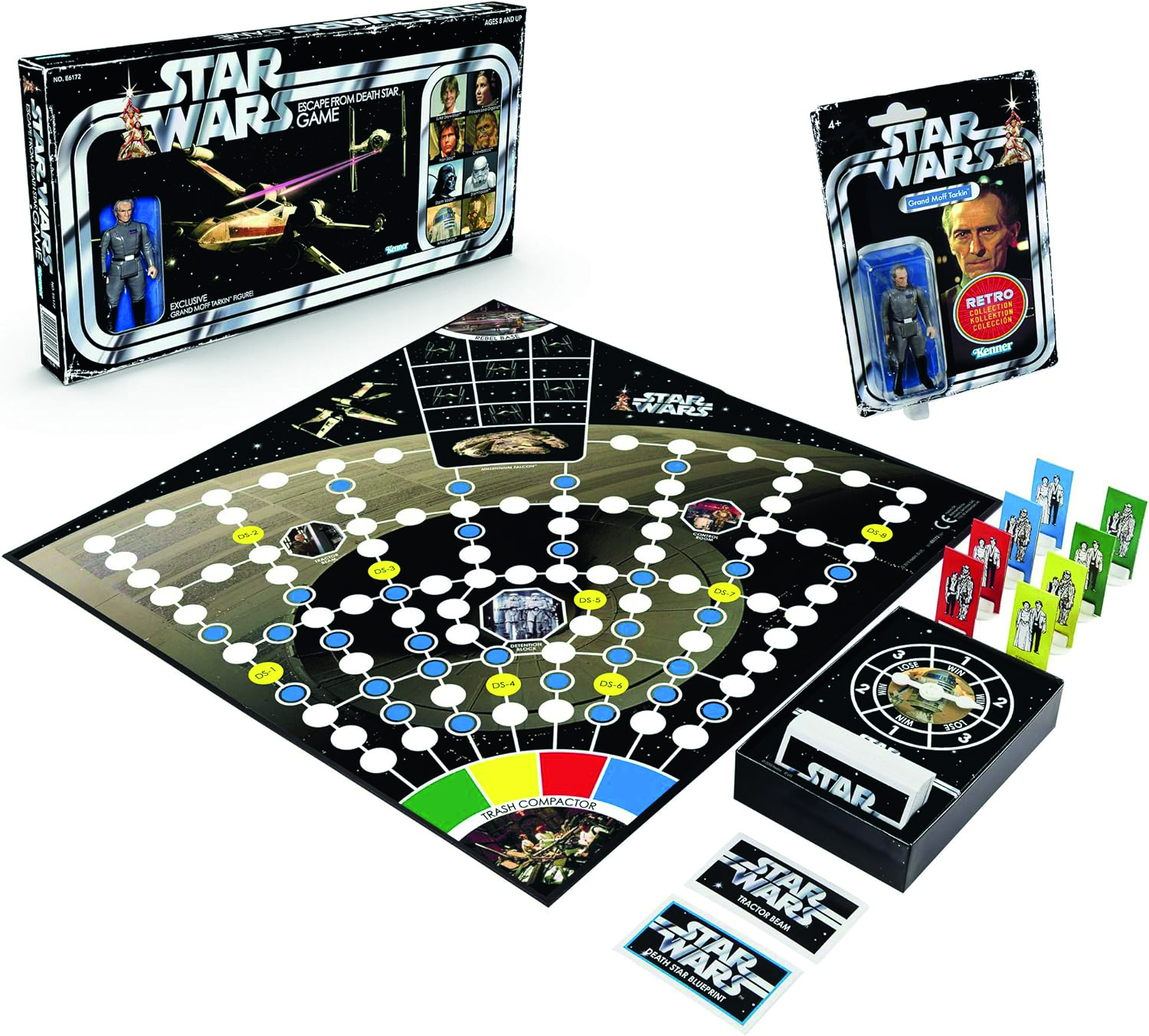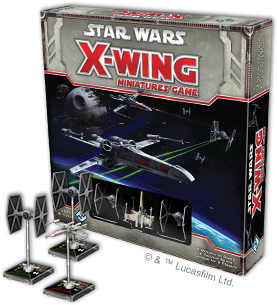25 April 2024
|
What really is the Force? George Barker investigates how game designers have presented their answer to this question in their games over the years.
What actually is the Force? Magic power? Convenient narrative device? Source of unlimited online arguments? Every adaptation of Star Wars gets to approach the Force in a new way. From books giving us insight into the mind of the user to video games and the satisfaction of pushing Stormtroopers off things. So where do board games fit in? Let's take a look at some of the ways players encountered the Force on the tabletop and hear from a few of the designers tasked with adapting this hokey religion.
What do we know about the Force?
With 678 entries for Star Wars games listed on Board Game Geek (BGG), we'll take Julie Andrews's advice and start at the very beginning. Six Star Wars board games were released alongside A New Hope in 1977. The only two to feature the Force were a pair of roll and move games published by Kenner. At this point, all anyone had seen the Force do on screen was confuse a stormtrooper, choke a subordinate, make an old man disappear and point a torpedo in the right direction. Working from this limited source material, Escape the Death Star and Destroy the Death Star employ the Force as a kind of divine influence, the will of the force arbitrarily helping or hindering players. It's the kind of luck that would have modern board gamers setting the game alight so it's no surprise that these games haven't exactly endured as classics.

Star Wars: Escape the Death Star Reprint
The idea that the Force has an element of cosmic agency helps separate it from just another system of magic. So as poorly as they've aged, and whether or not they simply cribbed chance cards from Monopoly, they did capture one of the more unique aspects of the Force.
Early Star Wars on Tabletop
A generation of kids were growing up with Star Wars and they wanted to play games that let them use Force powers. In the playground throwing out a hand to mime force push is more fun than explaining to your friends that you should win the game due to the idea of cosmic balance. Designers understood this and moved toward the Force as a player ability. However even after the culmination of the original trilogy the list of things the force could do was limited. What's more, now the films were finished, board games and TTRPGs shared the responsibility with books and comics for expanding the Star Wars universe. The Star Wars Roleplaying Game (1987), published by West End Games, became a major source of expanded universe material.
Related article: A History of Star Wars RPGs

Star Wars: The RPG
Alongside their TTRPG, they also published a series of more traditional board games including Assault on Hoth and the Battle for Endor worked on by Designer Doug Kaufman. Even with the licence to expand the universe, he describes the restrictions they worked around.
"As I recall, it was not about making 'a magic system' but rather finding the right balance of abilities seen in the movies and abilities that were strongly implied, as well as putting severe gates on those possessing the Force since, at the time, we were dealing with the franchise that specifically had very few Force users and even fewer trained ones. We also had to make sure the Dark Side didn't become so attractive that all players would want to pursue that."
According to a very helpful 2015 Bloomberg article breaking down Force powers in the Original and Prequel trilogies, there are roughly 10 discreet force powers displayed. The Star Wars Roleplaying game roughly doubled this, offering 23 different abilities to play with. Still this is relatively restrained by modern standards and as Doug mentioned, falling to the dark side was presented as a serious risk. Should players succumb, they lose control of their character.

Star Wars: Force & Destiny
28 years later, Fantasy Flight's Force & Destiny core book for their Star Wars roleplaying system gave player characters the chance to wield the Force. Speaking to Max Brooke, one of the designers behind the book, the vast expansion of the Star Wars franchise gave them a lot more space to work in.
"I was trying to cover a pretty wide gamut of abilities we'd seen in The Clone Wars and other media. When you're giving roleplayers tools, you really want to make a set of options that will inspire creative and unexpected choices at the table. So I really tried to give players a set of tools they could use in new ways I'd never even considered! I also spent a lot of time thinking about the way character development dovetails with Force powers. It was important that you not 'lose' Force powers just because you've fallen to the Dark side or redeemed yourself from it, and that your powers change with you across this journey. Creativity, self-expression, and the way a character progresses over a campaign were the top priorities."
RPGs are clearly a natural fit for simulating the force powers we daydream about having and the uncertainty of dice can be easily attributed to the 'will of the force'.
Utilising the Force in Games
In the pre-board game renaissance world of the 80s and 90s, most Star Wars games fell into the mass-market family camp or the more simulationist/war games being produced at West End Games targeting hobbyists. The prequel trilogy brought with it a wave of new games, perhaps most notable of which was Star Wars: The Queen's Gambit (2000). This elaborate production lets players enact the entirety of the Phantom Menace's climactic final act. With multi-level boards, handfuls of miniatures and custom dice, it would fit seamlessly alongside many over the top Kickstarters today. By all accounts it's something of a cult classic and now goes for £100s on eBay.

Star Wars: The Queen's Gambit
It fits into a category of what I'm going to term 'implied Force games'. In Queen's Gambit, one of its several boards is dedicated to the duel between Darth Maul, Qui-Gon and Obi-Wan. If either side wins, they're free to move to another board representing the battle between Padme's guards and the Trade Federation in Theed Palace. The guards and droid are evenly matched but a single force user entering the fray can easily swing the battle for their team. While the force isn't a specific mechanic, the super human power of a force user is clearly implied through the design.
Star Wars: Epic Duels (2002) let players battle teams of their favourite characters against each other. According to the designer Rob Daviau
"Different character decks had cards that implied the Force. Yoda would knock people over; Darth Vader would choke people; the Emperor used lightning."
Again, the Force is implied but the Jedi and Sith have to feel balanced when facing off against non-force users. If the battle between Jango Fett and Mace Windu was as brief as it is in the films, it wouldn't make for a very exciting game. Making the Force feel exciting and powerful while also keeping a game balanced is a real design challenge. More on that later.
Limitations of the Force
There's one consistent feature I'm seeing pop up time and again in Star Wars board games and that's some kind of Force track.

Star Wars: The Deckbuilding Game
From Risk: Star Wars - Original Trilogy Edition (2006) to Star Wars: The Deckbuilding Game (2023), Force tracks are everywhere. Asking Rob Daviau about his work on the Force meter in Risk he said:
"I don't have a copy of the game handy to see if I put the Force in it in any way… I found an old picture online and it looks like there's a Force Meter. That seems cool but I have zero idea what it does. Clearly it felt important to me."
Deployed as a shorthand for the cosmic tides of the Force, most examples confer bonuses to certain players depending on the balance between the dark side and the light side. It's a more mechanical approach to the Force as a divine influence than the random nature of Escape the Death Star and much less likely to frustrate modern board gamers.
Star Wars Miniatures Games
Some of the most successful Star Wars tabletop games in the last decade have been miniatures games. Star Wars: Legion and X Wing: the Miniatures Game feature specific Force mechanics and some of their most powerful commanders and pilots are Force users. The power of these characters is often the topic of debate in their competitive communities. How do you satisfy the player power fantasy of using the force and keep it balanced within a competitive setting?

X-Wing: The Miniatures Game
Related article: Review of Star Wars Legion Clone Wars Core Set
As well as his work on Force & Destiny, Max Brooke was one of the designers who introduced the Force as a mechanic in X Wing's second edition.
"We still wanted Jedi and other Force users to feel like powerful heroes and villains, but ultimately, a pilot in X-Wing is more of a static snapshot of a character than an RPG character. Instead of covering everything the Force can do, it was important that we capture the really cool moments iconic to specific characters. For the basic use of the Force, we really looked to Luke firing at the Death Star - the Force lets him survive the trench run and hit an impossible shot, so we knew it'd be something that made attacks more accurate and evasion more reliable."
Competitive players are often looking for certainty in their games and trying to make choices that minimise the role of luck on their chances of winning.
"We experimented with a Force die… But we found X-Wing players didn't really respond to the extra end-loaded randomness that a die introduced… So we made Force points a spendable resource to make dice rolls more reliable"

Star Wars: Shatterpoint
Star Wars' most recent miniatures game, Star Wars: Shatterpoint makes similar use of the force as a spendable resource but makes less of a clear delineation between those that can and can't use the force. In an interview, Star Wars: Shatterpoint designer Will Shick shared some of his thoughts on representing the Force.
"The Force is important to Star Wars because it touches everything. Everyone is connected by it…The force has a thing it's gonna do and it can work through anybody and through training and maybe a little bit of understanding, you can realise that more, but it doesn't stop you from being part of this wonderful tapestry… It allows characters like Clone Captain Rex or Lando and R2-D2 to have these really cool abilities that the force is a resource mechanic in bare bones game design terms. It's a critical resource mechanic that gives players the opportunity to be clever and to construct their own paths to victory"
Future of the Force
Is there a best way to represent the Force? Neither Star Wars: Rebellion nor Imperial Assault, the two games to make the BGG Top 100, feature a specific Force mechanic, implying its effects through other systems. Who knows what the future holds? More Star Wars games are a certainty but how will they represent the Force?
Want to read more? Try Through the Ages: Star Wars on Tabletop
Sometimes we may include links to online retailers, from which we might receive a commission if you make a purchase. Affiliate links do not influence editorial coverage and will only be used when covering relevant products







